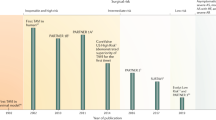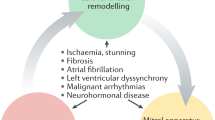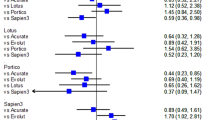Abstract
Several advances have been made in interventional cardiology, particularly in the field of valvular heart disease. Among the procedures for which technologies are available, percutaneous replacement of the pulmonary and aortic valves, and percutaneous repair of the mitral valve, via annuloplasty or the Alfieri method, are the best known. Along with the excitement generated by these new subspecialties, however, there has also been skepticism. In this article we focus on the current innovations that have been applied to the procedures in humans, and discuss the advantages and disadvantages of the different strategies.
Key Points
-
Percutaneous pulmonary valve replacement is feasible and has positive effects on right ventricular function
-
The mortality associated with percutaneous pulmonary valve replacement is zero, although limitations still exist in a notable number of patients who have large right ventricular outflow tracts
-
Percutaneous aortic valve replacement is feasible with bioprosthetic valves mounted on balloon-expandable and self-expandable stents
-
Although initial results of percutaneous aortic valve replacement are encouraging, delivery system size (currently 18–24 F) will have to be addressed for wider application of this procedure
-
Percutaneous mitral valve repair in humans includes techniques to perform edge-to-edge repair and annuloplasty via the coronary sinus
-
Limitations in percutaneous mitral valve repair will be seen mainly in patients with ischemic mitral regurgitation, in whom surgical repairs have historically not been as successful
This is a preview of subscription content, access via your institution
Access options
Subscribe to this journal
Receive 12 print issues and online access
$209.00 per year
only $17.42 per issue
Buy this article
- Purchase on Springer Link
- Instant access to full article PDF
Prices may be subject to local taxes which are calculated during checkout




Similar content being viewed by others
References
Bonhoeffer P et al. (2000) Percutaneous replacement of pulmonary valve in a right-ventricle to pulmonary-artery prosthetic conduit with valve dysfunction. Lancet 356: 1403–1405
Cribier A et al. (2002) Percutaneous transcatheter implantation of an aortic valve prosthesis for calcific aortic stenosis: first human case description. Circulation 106: 3006–3008
Feldman T et al. (2005) Percutaneous mitral valve repair using the edge-to-edge technique: six-month results of the EVEREST phase I clinical trial. J Am Coll Cardiol 46: 2134–2140
Cribier A et al. (2004) Early experience with percutaneous transcatheter implantation of heart valve prosthesis for the treatment of end-stage inoperable patients with calcific aortic stenosis. J Am Coll Cardiol 43: 698–703
Khambadkone S et al. (2005) Percutaneous pulmonary valve implantation in humans: results in 59 consecutive patients. Circulation 112: 1189–1197
Perron J et al. (1999) Valved homograft conduit repair of the right heart in early infancy. Ann Thorac Surg 68: 542–548
Bove EL et al. (1983) The influence of pulmonary insufficiency on ventricular function following repair of tetralogy of Fallot: evaluation using radionuclide ventriculography. J Thorac Cardiovasc Surg 85: 691–696
Bove EL et al. (1985) Improved right ventricular function following late pulmonary valve replacement for residual pulmonary insufficiency or stenosis. J Thorac Cardiovasc Surg 90: 50–55
Therrien J et al. (2000) Pulmonary valve replacement in adults late after repair of tetralogy of Fallot: are we operating too late? J Am Coll Cardiol 36: 1670–1675
Stark J et al. (1998) Fate of subpulmonary homograft conduits: determinants of late homograft failure. J Thorac Cardiovasc Surg 115: 506–514
Stark J (1998) The use of valved conduits in pediatric cardiac surgery. Pediatr Cardiol 19: 282–288
Hijazi ZM et al. (1996) Stent implantation for relief of pulmonary artery stenosis: immediate and short-term results. Cathet Cardiovasc Diagn 38: 16–23
Hosking MC et al. (1992) Intravascular stent prosthesis for right ventricular outflow obstruction. J Am Coll Cardiol 20: 373–380
Coats L et al. (2005) The potential impact of percutaneous pulmonary valve stent implantation on right ventricular outflow tract re-intervention. Eur J Cardiothorac Surg 27: 536–543
de Ruijter FT et al. (2002) Right ventricular dysfunction and pulmonary valve replacement after correction of tetralogy of Fallot. Ann Thorac Surg 73: 1794–1800
Dore A et al. (1997) Cardiac surgery for grown-up congenital heart patients: survey of 307 consecutive operations from 1991 to 1994. Am J Cardiol 80: 906–913
Bonhoeffer P et al. (2000) Transcatheter implantation of a bovine valve in pulmonary position: a lamb study. Circulation 102: 813–816
Coats L et al. (2005) Percutaneous pulmonary valve implantation in humans: an update in 88 patients. Circulation 112 (Suppl II): 2953
Bonhoeffer P et al. (2002) Percutaneous insertion of the pulmonary valve. J Am Coll Cardiol 39: 1664–1669
Boudjemline Y et al. (2005) Off-pump replacement of the pulmonary valve in large right ventricular outflow tracts: a hybrid approach. J Thorac Cardiovasc Surg 129: 831–837
Boudjemline Y et al. (2004) Percutaneous pulmonary valve replacement in a large right ventricular outflow tract: an experimental study. J Am Coll Cardiol 43: 1082–1087
Andersen HR et al. (1992) Transluminal implantation of artificial heart valves: description of a new expandable aortic valve and initial results with implantation by catheter technique in closed chest pigs. Eur Heart J 13: 704–708
Pavcnik D et al. (1992) Development and initial experimental evaluation of a prosthetic aortic valve for transcatheter placement: work in progress. Radiology 183: 151–154
Cribier A et al. (1986) Percutaneous transluminal valvuloplasty of acquired aortic stenosis in elderly patients: an alternative to valve replacement? Lancet 1: 63–67
Tron C et al. (2005) The RECAST study: short-term results after percutaneous aortic valve implantation in non-surgical patients with calcific aortic stenosis. Circulation 112 (Suppl II): 2952
Cribier A and Letac B (1988) Two years' experience of percutaneous balloon valvuloplasty in aortic stenosis. Herz 13: 110–118
Safian RD et al. (1988) Balloon aortic valvuloplasty in 170 consecutive patients. N Engl J Med 319: 125–130
NHLBI Balloon Valvuloplasty Registry (1991) Percutaneous balloon aortic valvuloplasty: acute and 30-day follow-up results in 674 patients from the NHLBI Balloon Valvuloplasty Registry. Circulation 84: 2383–2397
Cribier A and Letac B (1991) Percutaneous balloon aortic valvuloplasty in adults with calcific aortic stenosis. Curr Opin Cardiol 6: 212–218
Bauer F et al. (2004) Acute improvement in global and regional left ventricular systolic function after percutaneous heart valve implantation in patients with symptomatic aortic stenosis. Circulation 110: 1473–1476
Laborde JC et al. (2005) Percutaneous implantation of an aortic valve prosthesis. Catheter Cardiovasc Interv 65: 171–174
Grube E et al. (2005) First report on a human percutaneous transluminal implantation of a self-expanding valve prosthesis for interventional treatment of aortic valve stenosis. Catheter Cardiovasc Interv 66: 465–469
Hanzel GS et al. (2005) Retrograde percutaneous aortic valve implantation for critical aortic stenosis. Catheter Cardiovasc Interv 64: 322–326
Huber CH et al. (2004) Ultrasound navigation through the heart for off-pump aortic valved stent implantation: new tools for new goals. J Endovasc Ther 11: 503–510
Otto CM (2001) Clinical practice: evaluation and management of chronic mitral regurgitation. N Engl J Med 345: 740–746
Gorman JH III et al. (2003) Annuloplasty ring selection for chronic ischemic mitral regurgitation: lessons from the ovine model. Ann Thorac Surg 76: 1556–1563
Umana JP et al. (2003) 'Bow-tie' mitral valve repair: an adjuvant technique for ischemic mitral regurgitation. Ann Thorac Surg 66: 1640–1646
Fucci C et al. (1995) Improved results with mitral valve repair using new surgical techniques. Eur J Cardiothorac Surg 9: 621–626
Enriquez-Sarano M et al. (1995) Valve repair improves the outcome of surgery for mitral regurgitation: a multivariate analysis. Circulation 91: 1022–1028
McGee EC et al. (2004) Recurrent mitral regurgitation after annuloplasty for functional ischemic mitral regurgitation. J Thorac Cardiovasc Surg 128: 916–924
Carpentier A (1983) Cardiac valve surgery—the 'French correction'. J Thorac Cardiovasc Surg 86: 323–337
Maisano F et al. (1998) The edge-to-edge technique: a simplified method to correct mitral insufficiency. Eur J Cardiothorac Surg 13: 240–245
Maisano F et al. (2000) The double-orifice technique as a standardized approach to treat mitral regurgitation due to severe myxomatous disease: surgical technique. Eur J Cardiothorac Surg 17: 201–205
Bhudia SK et al. (2000) Edge-to-edge (Alfieri) mitral repair: results in diverse clinical settings. Ann Thorac Surg 77: 1598–1606
Calafiore AM et al. (2001) Mitral valve procedure in dilated cardiomyopathy: repair or replacement? Ann Thorac Surg 71: 1146–1152
Fann JI et al. (2004) Beating heart catheter-based edge-to-edge mitral valve procedure in a porcine model: efficacy and healing response. Circulation 110: 988–993
Maniu CV et al. (2004) Acute and chronic reduction of functional mitral regurgitation in experimental heart failure by percutaneous mitral annuloplasty. J Am Coll Cardiol 44: 1652–1661
Kaye DM et al. (2003) Feasibility and short-term efficacy of percutaneous mitral annular reduction for the therapy of heart failure-induced mitral regurgitation. Circulation 108: 1795–1797
Daimon M et al. (2005) Percutaneous mitral valve repair for chronic ischemic mitral regurgitation: a real-time three-dimensional echocardiographic study in an ovine model. Circulation 111: 2183–2189
Liddicoat JR et al. (2003) Percutaneous mitral valve repair: a feasibility study in an ovine model of acute ischemic mitral regurgitation. Catheter Cardiovasc Interv 60: 410–416
Sevensma M et al. (2005) In vivo analysis of the anatomical relationship of coronary sinus to mitral annulus and coronary arteries using cardiac multi-detector computed tomography—possible predictors of successful percutaneous mitral annuloplasty. Circulation 112 (Suppl 11): 2949
Mishra YK et al. (2006) Coapsys mitral annuloplasty for chronic functional ischemic mitral regurgitation: 1-year results. Ann Thorac Surg 81: 42–46
Grossi EA et al. (2005) Intraoperative effects of the coapsys annuloplasty system in a randomized evaluation (RESTOR-MV) of functional ischemic mitral regurgitation. Ann Thorac Surg 80: 1706–1711
Vassiliades TA Jr et al. (2005) The clinical development of percutaneous heart valve technology: a position statement of the Society of Thoracic Surgeons (STS), the American Association for Thoracic Surgery (AATS), and the Society for Cardiovascular Angiography and Interventions (SCAI) endorsed by the American College of Cardiology Foundation (ACCF) and the American Heart Association (AHA). J Am Coll Cardiol 45: 1554–1560
Boudjemline Y et al. (2005) Steps toward the percutaneous replacement of atrioventricular valves: an experimental study. J Am Coll Cardiol 46: 360–365
Vassiliades TA Jr et al. (2005) The clinical development of percutaneous heart valve technology: a position statement of the Society of Thoracic Surgeons (STS), the American Association for Thoracic Surgery (AATS), and the Society for Cardiovascular Angiography and Interventions (SCAI). Ann Thorac Surg 79: 1812–1818
Author information
Authors and Affiliations
Corresponding author
Ethics declarations
Competing interests
Alain Cribier is a consultant for Edwards Lifesciences.
Rights and permissions
About this article
Cite this article
Babaliaros, V., Cribier, A. & Agatiello, C. Surgery Insight: current advances in percutaneous heart valve replacement and repair. Nat Rev Cardiol 3, 256–264 (2006). https://doi.org/10.1038/ncpcardio0534
Received:
Accepted:
Issue Date:
DOI: https://doi.org/10.1038/ncpcardio0534



